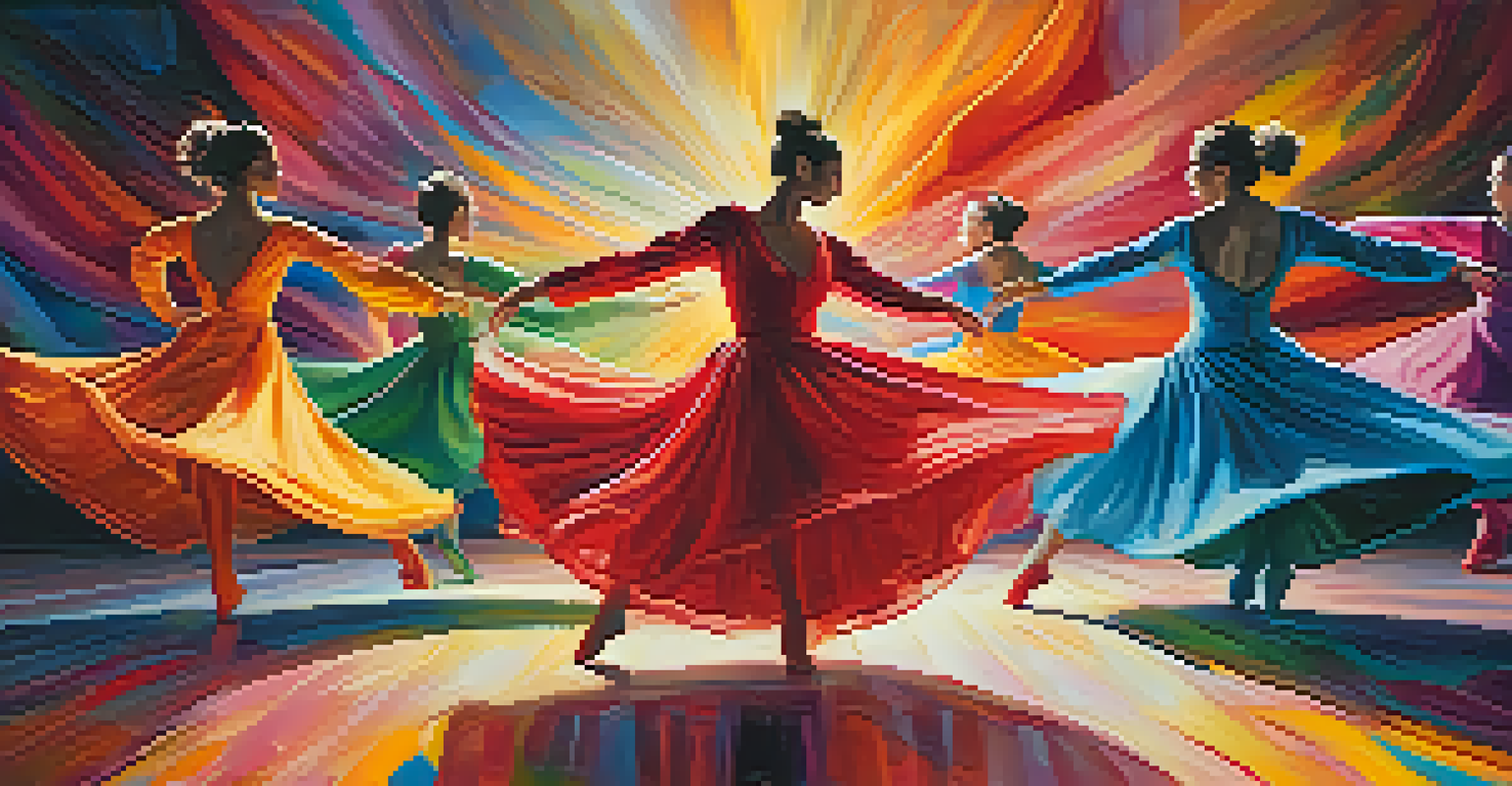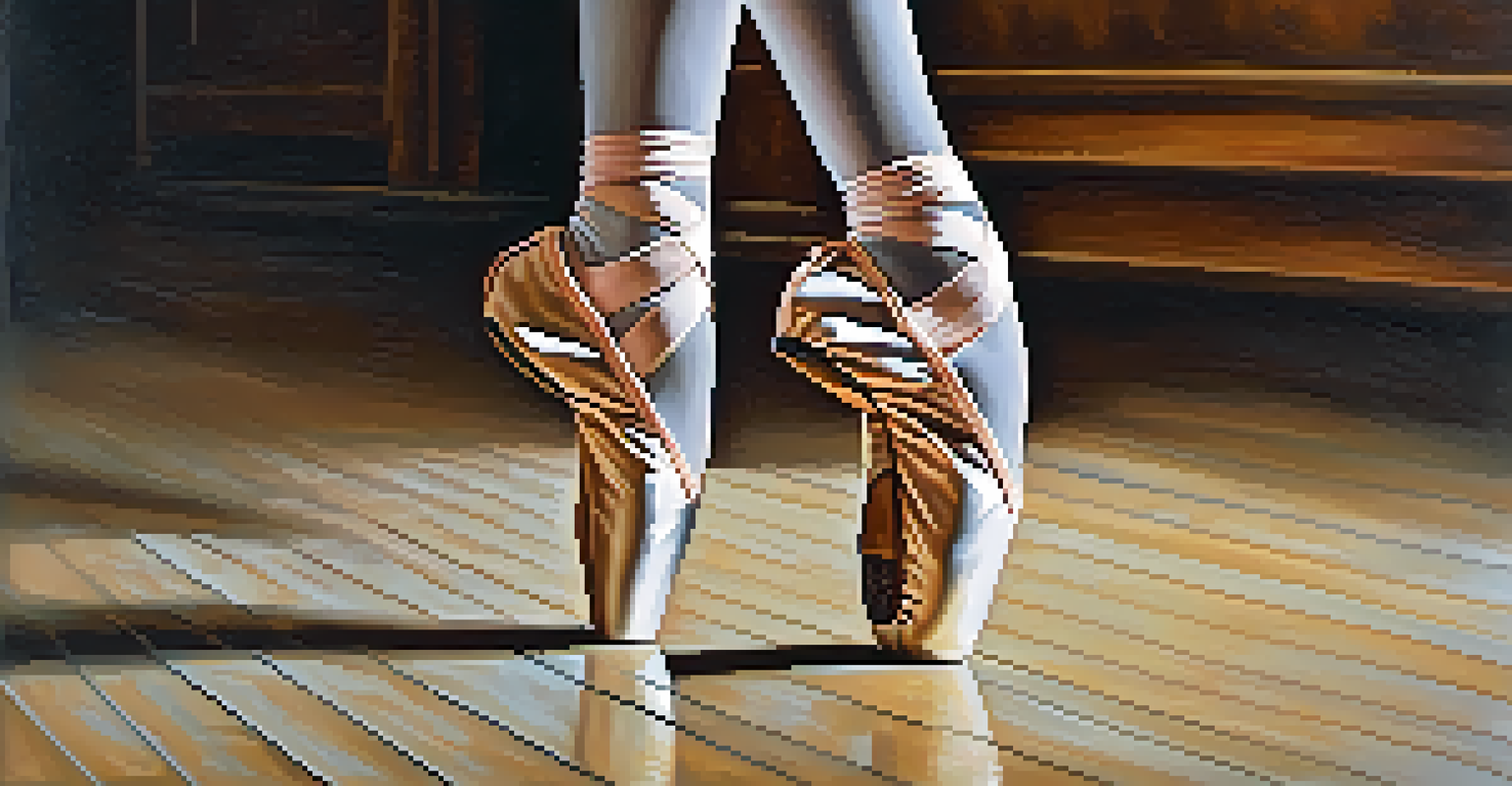Inspiration Sources for Choreographers: Nature, Art, and Life

Nature as a Choreographic Muse
Nature is a profound source of inspiration for choreographers, offering a visual and emotional palette that can transform movement into a narrative. The way the wind sways trees, or how waves crash on the shore, can influence the fluidity and rhythm of dance. For instance, a choreographer might mimic the graceful flutter of leaves or the powerful thrust of ocean currents in their choreography.
Dance is the hidden language of the soul.
Additionally, the changing seasons provide a dynamic backdrop for creativity. Spring's rebirth can inspire themes of renewal and growth, while winter's stillness might evoke introspection and solitude. By observing these natural cycles, choreographers can create pieces that resonate deeply with audiences, reflecting the beauty and complexity of the world around us.
Moreover, incorporating elements from nature into choreography can create a multi-sensory experience for viewers. Using props like flowers, stones, or water can enhance the connection between dance and the natural environment, making performances more immersive and impactful. Ultimately, nature not only sparks inspiration but also grounds choreographic work in something universally relatable.
Artistic Influences in Choreography
Art, in its many forms, serves as a significant source of inspiration for choreographers. Whether it's a painting, sculpture, or a piece of music, visual and auditory arts can ignite the creative spark needed to choreograph a dance. For example, a vibrant painting could inspire a choreographer to explore colors and emotions through movement, capturing the essence of the artwork on stage.

Moreover, the interplay between different art forms can lead to innovative dance compositions. Collaborations with visual artists or musicians can create a rich tapestry of creativity, where each discipline enhances the other. A choreographer might interpret the rhythm of a musical score through dynamic movements, allowing the audience to experience both the sound and the dance in harmony.
Nature Inspires Choreography
Choreographers draw from the beauty and rhythms of nature to create movements that resonate with audiences and reflect the world around us.
Additionally, historical art movements can provide thematic direction for choreography. The bold statements of Expressionism or the fluidity of Impressionism can inspire choreographers to embody those styles in their work, allowing dancers to communicate deeper emotions and narratives through their movements. This cross-pollination of ideas keeps the art of dance fresh and relevant.
Life Experiences as Choreographic Fuel
Choreographers often draw from their personal life experiences to inform their work. The joys, struggles, and milestones of life can translate into profound movements that resonate with audiences on a personal level. For instance, a choreographer might reflect on a significant relationship or a pivotal moment in their life, using dance as a medium to express complex emotions and stories.
Art is the most beautiful of all lies.
Moreover, shared experiences within communities can also serve as rich sources of inspiration. Choreographers may explore themes of culture, identity, and social issues through dance, creating pieces that reflect the collective experiences of their communities. This not only gives voice to shared narratives but also fosters a sense of connection and understanding among audiences.
Additionally, the everyday moments of life can offer unexpected inspiration. Simple actions, like walking, laughing, or even waiting, can be transformed into movement sequences that highlight the beauty of the ordinary. By finding grace and artistry in daily life, choreographers can create relatable and engaging performances that invite the audience to see the world through a new lens.
Historical Context in Dance Creation
The history of dance itself is a treasure trove of inspiration for choreographers. By studying past styles, movements, and notable figures, choreographers can draw from a rich legacy that informs their own creative processes. For instance, revisiting classical ballet techniques can enhance a contemporary piece, blending the elegance of the past with modern expression.
Moreover, understanding the social and cultural contexts of previous dance eras can provide depth to new works. Choreographers can weave historical narratives into their performances, giving audiences insight into how dance has evolved over time and reflecting societal changes. This can create a dialogue between the past and present, enriching the viewer's experience.
Art Fuels Dance Creativity
Interdisciplinary influences from visual and auditory arts ignite innovative choreography, allowing dancers to express complex emotions and narratives.
Additionally, historical events can serve as poignant themes for choreography. Choreographers may choose to interpret significant moments in history through dance, using movement to communicate the emotions and impacts of those events. This not only educates audiences but also honors the stories of those who came before us, making dance a powerful medium for storytelling.
Emotions as a Driving Force in Dance
Emotions are at the heart of every dance, providing a driving force for choreographers. Feelings like love, sadness, joy, and anger can be transformed into movement that speaks to the human experience. A choreographer might create a piece that embodies the intensity of heartbreak, using sharp, erratic movements to convey turmoil and loss.
Additionally, emotional responses to music can significantly influence choreography. The tone, tempo, and rhythm of a musical piece can evoke specific feelings, guiding the choreographer in how to express those emotions through movement. This synergy between music and dance allows for powerful storytelling that resonates with audiences on a visceral level.
Furthermore, exploring the emotional landscape of dance can open up new creative avenues. Choreographers might experiment with contrasting emotions within a single piece, creating a dynamic interplay that captivates viewers. By tapping into the complexity of human emotions, choreographers can create work that is not only technically impressive but also deeply moving.
Cultural Influences in Dance Creation
Cultural heritage plays a vital role in shaping the work of many choreographers. By incorporating traditional elements from their backgrounds, choreographers can celebrate and preserve their cultures through dance. For example, a choreographer might weave folkloric movements into contemporary choreography, creating a fusion that honors both traditions.
Moreover, the exploration of diverse cultures can enhance a choreographer's artistic vocabulary. By learning from various dance styles and forms worldwide, they can create pieces that reflect a global perspective. This cross-cultural exchange not only enriches their work but also broadens the audience's understanding and appreciation of different traditions.
Emotions Drive Dance Expression
Choreographers harness a range of emotions to create powerful movements that connect with audiences on a personal level.
Additionally, cultural narratives can serve as powerful sources of inspiration. Choreographers may choose to tell stories rooted in their cultural backgrounds, exploring themes of identity, migration, and community. This storytelling through dance can foster connections and encourage conversations about cultural significance, making performances a platform for dialogue and understanding.
Collaboration and Inspiration in Dance
Collaboration is a crucial aspect of the creative process for many choreographers. Working alongside other artists, such as musicians, visual artists, or writers, can lead to unique perspectives and innovative ideas. This teamwork often sparks new concepts that a choreographer might not have considered alone, enriching the final performance.
Moreover, collaborative projects can allow for a blending of styles and techniques. For instance, a choreographer may partner with a filmmaker to create a dance film, resulting in a visual narrative that combines movement with cinematic elements. This fusion of art forms can captivate audiences and push the boundaries of traditional dance.

Additionally, engaging with fellow dancers can provide valuable insights and inspiration. Dancers bring their own experiences, emotions, and interpretations to the table, which can influence the choreography itself. By fostering an environment of collaboration, choreographers can create works that are not only cohesive but also reflect a diversity of voices and ideas.